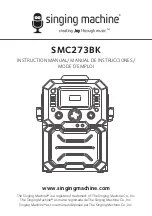
Quality
•
Reliability
•
Performance
Weldmatic 150
Model No CP121, Iss B 07/08
13
Quality
•
Reliability
•
Performance
Establishing a Weld Setting
Once the consumable wire type, wire size
and shielding gas have been chosen, the two
variables that are adjusted in order to obtain
a the desired weld setting are;
• Wirefeed speed,
• Welding arc voltage.
The Weld Setting Charts in Figure 4 can be
used to preset the machine for an approximate
welding current. For each of the combinations
of voltage control switch settings, there is a
range of valid wirespeed settings.
The wirefeed speed determines the welding
current; increasing the speed increases the
current, and decreasing it decreases current.
The selected wirefeed speed must be
matched with sufficient arc voltage; a speed
increase requires an increase of arc voltage.
If the voltage is too low the wire will stub
and stutter, and there will not be a steady
arc. If the voltage is too high the arc will be
long with metal transfer occurring as a series
of large droplets.
Important:
Do not operate the Voltage
Control switches during welding.
The weld setting should be chosen to suit the
application and the thickness of the metal to
be welded. It is important to check that the
deposited weld provides sufficient strength
to suit the application.
A “good” weld will have the characteristics
illustrated in Figure 5. The weld has penetrated
into the parent metal, fusing the root of the
joint where the two plates meet, and the weld
blends smoothly into the side walls.
A “bad” weld is shown in Figure 6. The weld
has not penetrated the joint root, and there
is poor side wall fusion. This lack of fusion
would normally be corrected by increasing
the arc voltage, or by increasing both
wirefeed speed and arc voltage to achieve a
higher current weld setting.
Fig 5
“Good” Weld
Fig 6
“Bad” Weld
Gun Position
For “down hand” fillet welding with gas
shielded solid wires, the gun is normally
positioned as shown in Figure 7a below, with
the nozzle end pointing in the direction of
travel.
For “down hand” fillet welding with
gasless flux cored wires, the gun is normally
positioned as shown in Figure 7b below,
with the nozzle end pointing away from the
direction of travel, referred to as ‘dragging’
the weld. Gasless flux cored wires should be














































